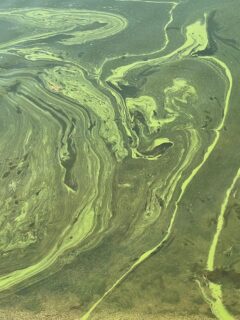by Lindsay Chutas and Kennet Bertelsen, PE, Morrison-Maierle Inc.

Algae bloom near the north end of Lake Newman, summer 2022, near one of the properties signed up to participate in Phase 2 of the treatment project.
Poor water quality has been a widespread, long-term issue impacting property owners around Newman Lake. Previous studies have shown that stormwater runoff and inadequate septic systems are contributing to elevated nitrogen and phosphorus levels in the lake. Most of the phosphorus loading at Newman Lake is in the form of biological reactive phosphorus and is readily available for immediate algal uptake upon reaching the lake. Many parcels around the lake cannot meet current on-site sewage (OSS) disposal requirements. This is primarily due to lack of available area for primary and secondary drainfields or poor soil conditions.
Phase One of the Newman Lake Pilot Advanced Wastewater Pilot Study tested two membrane bioreactor (MBR) systems for their effectiveness in treating wastewater with a smaller footprint and without a soil treatment component, unlike traditional and advanced OSS systems. For the first phase of the pilot study, an above-ground Busse GT system replaced a cesspool with no drainfield, and added a drip irrigation line for the disposal of the treated water. A tank-based Biomicrobics Biobarrier system replaced a failed gravity system with an undersized drainfield. The two systems reduced nitrogen by 97.9%, phosphorus by 98.1% (with an additional phosphorus scrubber), and fecal coliform by 99.9%. Phase Two of the pilot study will test up to 15 MBR systems in a variety of sites around Newman Lake to determine the broader feasibility of using these enhanced systems to help improve wastewater treatment capabilities to replace failing or aging septic systems.

View from Honeymoon Bay, Lake Newman, looking north toward Mt. Spokane. This is the location of the two systems installed in Phase 1 of the project.
Washington State Department of Ecology has awarded the Spokane Conservation District grant funds and money for low-interest loans to help incentivize installing these systems around Newman Lake. Morrison-Maierle, the project engineering lead, would like to connect with other shoreline communities around Washington State to implement similar pilot programs as a way of doing a paired study, improving water quality at other lake communities, and applying pressure to regulatory agencies to develop a lasting permit mechanism. Ideal communities would have properties that are undersized for standard drainfields and currently have difficulty meeting regulatory requirements for OSS systems. The Spokane Conservation District and Morrison-Maierle have been working together to close the regulatory gap with Ecology, the Department of Health, and the Spokane Regional Health District. Please reach out to Lindsay Chutas for more information at lchutas@m-m.net









